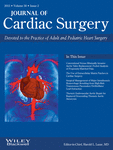Ventricular Assist Devices and Increased Blood Product Utilization for Cardiac Transplantation
ABSTRACT
Background and Aim of Study
The purpose of this study was to examine whether blood product utilization, one-year cell-mediated rejection rates, and mid-term survival significantly differ for ventricular assist device (VAD patients compared to non-VAD (NVAD) patients following cardiac transplantation.
Methods
From July 2004 to August 2011, 79 patients underwent cardiac transplantation at a single institution. Following exclusion of patients bridged to transplantation with VADs other than the HeartMate II® LVAD (n = 10), patients were stratified by VAD presence at transplantation: VAD patients (n = 35, age: 54.0 [48.0–59.0] years) vs. NVAD patients (n = 34, age: 52.5 [42.8–59.3] years). The primary outcomes of interest were blood product transfusion requirements, one-year cell-mediated rejection rates, and mid-term survival post-transplantation.
Results
Preoperative patient characteristics were similar for VAD and NVAD patients. NVAD patients presented with higher median preoperative creatinine levels compared to VAD patients (1.3 [1.1–1.6] vs. 1.1 [0.9–1.4], p = 0.004). VAD patients accrued higher intraoperative transfusion of all blood products (all p ≤ 0.001) compared to NVAD patients. The incidence of clinically significant cell-mediated rejection within the first posttransplant year was higher in VAD compared to NVAD patients (66.7% vs. 33.3%, p = 0.02). During a median follow-up period of 3.2 (2.0, 6.3) years, VAD patients demonstrated an increased postoperative mortality that did not reach statistical significance (20.0% vs. 8.8%, p = 0.20).
Conclusions
During the initial era as a bridge to transplantation, the HeartMate II® LVAD significantly increased blood product utilization and one-year cell-mediated rejection rates for cardiac transplantation. Further study is warranted to optimize anticoagulation strategies and to define causal relationships between these factors for the current era of cardiac transplantation. doi: 10.1111/jocs.12474 (J Card Surg 2015;30:194–200)




